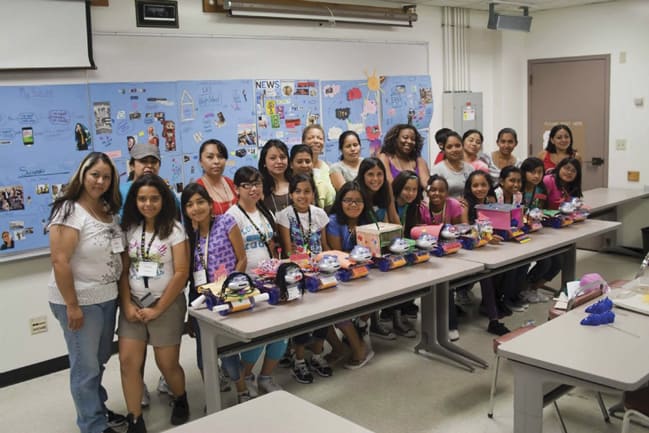Jared Mauldin, an engineering student at Eastern Washington University, caused a stir earlier this month when he declared that men and women in STEM are definitely not equal. “I did not grow up in the world that discouraged me from focusing on hard science,” he explained in a letter to the editor of his student paper. “Nor did I live in a society that told me not to get dirty, or said I was bossy for exhibiting leadership skills.”
Mauldin’s comments struck a chord with many women who believe their path into engineering has been a bigger struggle than their male colleagues. “A boy tells someone that he wants to be an engineer and the reaction is ‘that’s fantastic, what type?’” said Hannah Pearlman, a finalist in the 2014 IET Young Woman Engineer of the Year awards. “When I told people I wanted to be an engineer the reaction was: ‘Really? Wow, isn’t that a very male industry?’”

It’s a view that industry has recognised in recent years. Various initiatives have been launched specifically to encourage women to follow careers in engineering. For instance the Women’s Engineering Society (WES), has recently introduced a new project dubbed Sparxx, which targets girls between the ages of 11 and 18 who express an interest in STEM. But there’s also been a backlash against this type of positive discrimination. One of the most common comments is that ‘society shouldn’t force girls and women into roles they obviously don’t want to do’.
Research, however, has shown that girls are just as interested as boys in STEM and engineering up to a certain age, then they get discouraged. In a recent study of nine and 10 year-olds by the National Science Foundation, 66 per cent of girls and 68 per cent of boys reported liking science. But something else starts happening a few years earlier. At the age of seven, when students were asked to draw a scientist, most portrayed a white male in a lab coat. If they did draw a female scientist, she often looked severe and unhappy. By the age of 13, boys are twice as interested in STEM careers as girls.
”When I told people I wanted to be an engineer the reaction was: ‘Really? Wow, isn’t that a very male industry?’
Hannah Pearlman, finalist, 2014 IET Young Woman Engineer of the Year
Today, only seven per cent of engineering professionals in the UK are female, and the proportion is even lower for engineering apprentices at just over four per cent. The dearth of female engineers is a problem across the world, however, the UK has the lowest representation of women in engineering across Europe. With the sector battling a skills gap, addressing this imbalance has become more crucial than ever.
But what puts young girls off engineering at such a young age? A lack of encouragement from parents and teachers is at the heart of the issue. “One thing that always disappoints me is when I hear young girls come out with statements such as ‘I’m just not good at maths’, which is a crazy thing to be saying at the age of 10,” said Naomi Mitchison, IET Young Woman Engineer of the Year. “I think part of the problem is that this attitude in girls is acknowledged and accepted by parents and teachers, in a way that just doesn’t happen to young boys.”
Mitchison also thinks a major problem is that parents, teachers and career advisors don’t really understand what engineering is themselves. As a result, their outdated and inaccurate views of these jobs are passed onto young girls. “I don’t think it’s a coincidence that so many female engineers had a family member in engineering who inspired them growing up, because these women are the ones who had the most realistic idea of what engineering actually involves,” said Mitchison.
”There is no single typical girl and to pigeon-hole them into particular disciplines risks ignoring the myriad reasons that girls can be attracted to the profession.
Jenny Young, Royal Academy of Engineering
And the problem is more serious than many believe. “At a recent outreach activity run by the Women’s Engineering Society one young girl commented to me that she didn’t even know that women were allowed to become engineers,” recalls Dawn Bonfeld, former president of the Women’s Engineering Society. “As a society we have held these stereotypes for so long that they become difficult to shift, and our unconscious and conscious biases are passed on to the next generation all too easily.”
In an effort to encourage more women into the sector, various initiatives are promoting what some people believe are more female-centric aspects of engineering. The stereotype suggests that this is in careers that make a positive impact to society, such as environmental engineering. Lina Nelsson, a biomedical engineering lecturer from the University of California, Berkeley, claimed that if the content of work is made more societally meaningful, women will enrol on her course in droves. But she says that also applies to more traditional, male-dominated fields such as mechanical and chemical engineering.
“There is anecdotal evidence that suggests girls may be more interested in the social aspects of engineering and its potential to help people,” said Jenny Young, head of diversity at the Royal Academy of Engineering. “However I think this is a dangerous generalisation. There is no single typical girl and to pigeon-hole them into particular disciplines risks ignoring the myriad reasons that girls can be attracted to the profession.””




April 1886: the Brunkebergs tunnel
First ever example of a ground source heat pump?